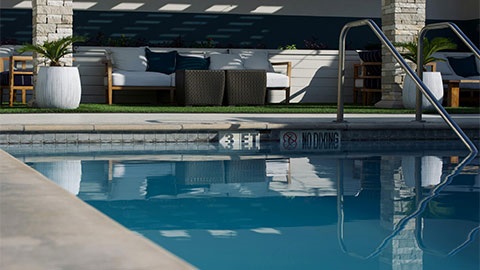Swimming pools, spas and portable wading pools

A pool, including spas and portable wading pools, is a structure filled with water used for swimming, wading, or paddling.
Building a new pool or spa
All new swimming pools and spas, including blow-up ones, that can fill with water to a depth of more than 300 millimetres and have a volume of more than 2,000 litres need building approval. This includes safety fencing. Approval is issued by a private building certifier, who must inspect and certify the structure. Find out more about building approval.
Depending on the way you connect any backwash pipework, you may also need plumbing approval. Contact your local plumber or drainer.
To ensure your outdoor pool meets building requirements, check the Queensland Development Code.
Removal and demolition of a swimming pool or spa
Before starting work to decommission a pool or spa, you must get building approval.
If your pool safety fence is part of a dividing fence, there are procedures to follow. Learn more about dividing fences as pool barriers.
Once you have the final inspection certificate, the pool owner should remove the pool from the QBCC register.
Restrictions when demolishing a pool or spa
Before emptying the pool or spa water into your sewerage network, contact UnityWater. They will let you know of any restrictions in your area.
You can empty your pool into the stormwater system if confirmed that there are no chemicals in the water and the pH is within a range of 6.5 to 8.5.
Otherwise, contact a licensed liquid waste contractor to empty the pool or spa.
For more information, refer to the Environmental Protection Act 1994.
Pool and spa safety requirements
State Government legislation requires owners of pools and spas to ensure compliance with pool fencing standards. For your requirements and responsibilities, visit the QBCC website.
Pool and spa fencing
Pools and spas must have a compliant fence or barrier.
If you are unsure if your fencing is compliant or for complex fencing, engage a licensed pool safety inspector for a full safety audit.
For more information on the pool safety standards for fences, gates, latches, or to find a licensed pool safety inspector, view the Pool safety standard.
Replacing a pool or spa fence
If you want to replace the entire pool fence, engage a pool safety inspector before starting work. They will inspect the fence and issue a non-conformity notice.
The non-conformity notice will address the work needed to reach compliance.
The same pool safety inspector must return to inspect the completed works within 3 months. If the fence is not compliant, the inspector will issue another non-conformity notice.
When you remove sections of your pool fence, you must ensure that there is temporary fencing installed during repairs.
CPR Sign
For all pools and spas, you must display a CPR sign that:
- shows how to perform CPR
- is attached to the fence or displayed nearby and highly visible
- is at least 300 millimetres by 300 millimetres in size
- is made of a durable and weatherproof material
- includes a prominent statement explaining how to act in an emergency. For example, call 000, stay with the injured person, and provide first aid
- complies with the Australian Resuscitation Council’s resuscitation guidelines.
Selling or leasing a property with a pool or spa
When you are selling or leasing a property with a pool or spa, you will need a valid pool safety certificate from a licensed pool safety inspector.
Different certificate validity applies to private and shared pools. You do not need to get a new certificate before each sale or lease.
- pools in a private dwelling, certificates are valid for 2 years.
- pools in shared complexes, certificates are valid for 1 year.
The QBCC provides a search tool to locate pool safety inspectors.
To view details of the most recent pool safety certificate, you can search the QBCC swimming pool register.
Council's role with pool and spa safety
City of Moreton Bay has an obligation to enforce the pool safety standards.
Council may issue on-the-spot fines if made aware of unlawful or non-compliant structures.
For more information and to learn more about the role of Local Government, which includes a Pool Safety guideline, refer to Local council's role in pool safety.